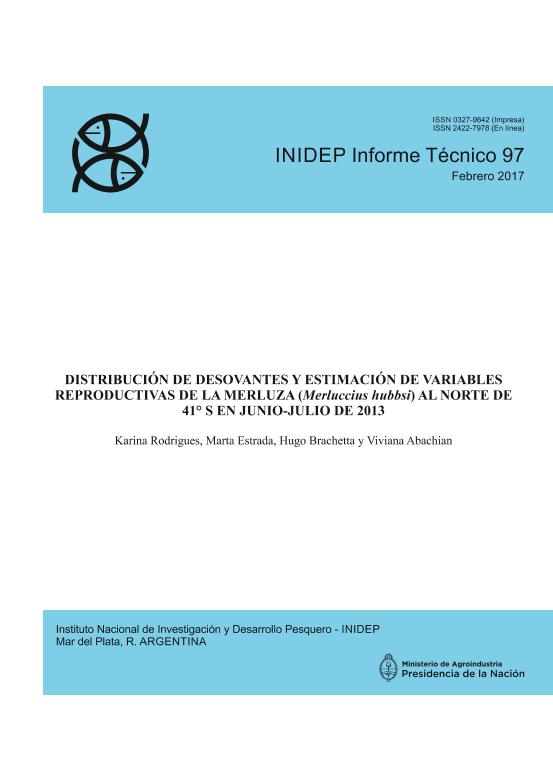Artículo
Se analizó el área de desove, la frecuencia de puesta, la fecundidad y el peso seco ovocitario del efectivo norte de merluza en junio-julio de 2013. Los resultados indicaron que la actividad reproductiva de la especie en la región bonaerense durante esos meses tuvo lugar, esencialmente, al norte de los 37º S, en proximidades de la isobata de 50 m en un rango de temperatura de entre 6-13,5 ºC que coincide con un frente térmico de fondo. Los valores de fecundidad parcial (entre 56.431 y 2.203.472 ovocitos hidratados). de fecundidad relativa (entre 175 y 970 ovocitos hidratados g· 1) y la frecuencia de puesta (14 días) se encontraron en el mismo rango que los obtenidos en el mes de mayo de años anteriores. La relación entre la fecundidad parcial y las variables longitud total, peso eviscerado, edad e indice hepatosomático (IHS) resultaron positivas en todos los casos, lo que evidencia un incremento del número de huevos producidos con las características maternas analizadas. El peso seco ovocitario, que mostró una relación significativa con la talla, el peso eviscerado, la edad y el IHS, sugiere que los ejemplares de mayor tamaño invierten energía para aumentar la cantidad y mejorar la calidad de los ovocitos producidos. The reproductive area, spawning frequency, fecundity and oocyte dry weight of the Northern hake stock in June-July 2013 were analyzed. Results indicated that the reproductive activity of the species in the Buenos Aires region during those months took place, mainly, north of 37° S, near the 50 m isobath in a 6-13.5 °C temperature range that coincides with a bottom thermal front. Values of batch fecundity (between 56,431 and 2,203,472 hydrated oocytes), relative fecundity (between 175 and 970 hydrated oocytes g-1) and spawning frequency (14 days) were in the same range than those obtained in May in previous years. The relationship between batch fecundity and total length, gutted weight, age and hepatosomatic index (HSI) variables were positive in all cases, which indicates an increase in the number of eggs produced with the maternal characteristics analyzed. The oocyte dry weight, that showed a significant relationship with length, gutted weight, age and the HSI, suggests that the largest specimens invest energy to increase the amount and improve the quality of the oocytes produced.
Distribución de desovantes y estimación de variables reproductivas de la merluza (Merluccius hubbsi) al norte de 41° S en junio-julio de 2013
Título:
Spawners distribution and reproductive variables estimate of argentine hake (Merluccius hubbsi) north of 41° S in june-july 2013
Fecha de publicación:
02/2017
Editorial:
Instituto Nacional de Investigación y Desarrollo Pesquero
Revista:
Revista de Investigacion y Desarrollo Pesquero
ISSN:
0325-6375
Idioma:
Español
Tipo de recurso:
Artículo publicado
Clasificación temática:
Resumen
Palabras clave:
Merluccius Hubbsi
,
Efectivo Norteño
,
Frecuencia de Puesta
,
Fecundidad
Archivos asociados
Licencia
Identificadores
Colecciones
Articulos(CCT - MAR DEL PLATA)
Articulos de CTRO.CIENTIFICO TECNOL.CONICET - MAR DEL PLATA
Articulos de CTRO.CIENTIFICO TECNOL.CONICET - MAR DEL PLATA
Articulos(IIMYC)
Articulos de INSTITUTO DE INVESTIGACIONES MARINAS Y COSTERAS
Articulos de INSTITUTO DE INVESTIGACIONES MARINAS Y COSTERAS
Citación
Rodrigues, Karina Andrea; Estrada, Marta; Brachetta, Hugo; Abachian, Viviana; Distribución de desovantes y estimación de variables reproductivas de la merluza (Merluccius hubbsi) al norte de 41° S en junio-julio de 2013; Instituto Nacional de Investigación y Desarrollo Pesquero; Revista de Investigacion y Desarrollo Pesquero; 97; 2-2017; 1-20
Compartir




